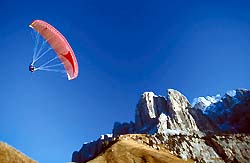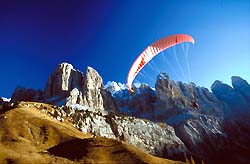| Have a Go! | |||||||||||||||||||||||||||||||||||||||||||||||||||||||||||||||||||||||||||||||||||||||||||||||
| Search the site | |||||||||||||||||||||||||||||||||||||||||||||||||||||||||||||||||||||||||||||||||||||||||||||||
|
Flight Test - Nova X-act 27 From Skywings Another welcome addition to the DHV 1/2 class! Nova's X-act range is scaled up - and down - from the 25 model (something Nova call the Zoom factor!). Thus all five models in the range (covering all-up weights from 55 - 130kg*) have 31 cells plus four closed cells at each wingtip. It's unusual to find a glider certificated in so many sizes, enabling precise matching of pilot weight to glider size for optimum loading, but it does mean you have to work out your flying weight exactly (stand on the bathroom scales with rucksack, glider, harness, reserve, instruments, monkeys and parrots, the lot!). If you haven't done this - and you should - it's useful to note that manufacturers estimate that pilots fly with 15 - 18kg of equipment. The 27 model covers the range 100 - 130kg and I flew it at an all-up weight of 115kg. Construction The riser set up is a three-riser system, but the A and B risers are sewn together about 20 cm from the hang point (and thus respond to the speed system), with the C as the rear riser. A separate A1 riser, pop-studded to the A2, attaches to a single line to facilitate big ears. Brake lines are connected via a metal ring, eliminating material-to-material brake handle wear. Construction is good and accurate throughout, and Nova should be complimented on the care with which the manual explains, through words and diagrams, how the glider should be rigged and operated. In the air The speed system is a simple two-pulley, 3:1 ratio arrangement, giving about 10cm of travel to full extension. The speed bar comes with strong spring clips, the manual cautioning that brake lines can get trapped in less strong clips during reverse launches. When pressed out, acceleration is felt from the middle of the speed bar travel, and the recommended full extension setting, with both pulleys touching, is easily reached. The manual specifically warns against any application of brakes in this condition as it decreases stability rather than increasing it as in normal flight.
I had a long think about the riser system before attempting a B-line descent, wondering what effect having the A-lines joined to the same main riser would have. The answer is little or none, except the A-risers come back onto your hands as you haul on the Bs. How fast you come down depends on how much you pull, but there is a stage where the response kicks in more profoundly and you are definitely in rapid-descent mode. Riser release can be quick but the canopy damps itself out well. The X-act flies fast and the sink rate is good. Brake pressure is not high, but firm in turns with one hand up, one down. The glider can be 'wingovered' but the energy on exit out is not terrifically high. In turbulence you get the feel of the bumpy air passing through but not pitching you. Weight shift makes life easier but is not essential when starting out. The canopy doesn't rock too much when changing brake quickly - a good point for scratching. Soaring in lift can be fairly passive; turning into lift and flying fast, then chasing the lift back with the tip. The secure feeling lets you fly fast; there's little need to keep lots of brake on or to keep feeling for collapses. The asymmetric tuck is not terribly dramatic when induced, beginning to come out on its own with little indication that the glider wants to turn dramatically. I did not completely stall the glider - I didn't have 3,000ft to play with and I didn't want to strain the material - and there's little point in deliberately entering a dangerous manoeuvre that is rarely encountered in normal flight. Stall recognition, however, is important, and I slowed the glider gradually to explore this. Brake feel and loss of wind noise made the onset of the stall readily identifiable; recovering with hands up gave rise to a little pitch and a surge. Soaring an English hill in winter, with all its variations of windspeed, plus bumps, a spit of rain and the cold, the X-act was still a pleasure to fly. The kit comes in a comfy-to-carry rucksack with a little windsock, sexy hat… and a stuff sack that appears to be made to appeal to an acid-blind hippy! But I commend the manual; as well as data on the glider, most of the (extremely detailed) advice is sound enough for any paraglider. Overall * There is actually a sixth X-act model, the XL, which doubles as a tandem wing (see spec. table). Specification
* All-up weights Summary Positive points Negative points Importer: Active Edge, Albert Terrace, Glasshouses, Harrogate, North Yorkshire HG3 5QN, tel: 01423 711900, fax: 01423 712900, e-mail: Active_Edge@ compuserve.com, website: www.nova-wings.com/ Manufacturer's comment Hannes Papesh, Nova
|
|||||||||||||||||||||||||||||||||||||||||||||||||||||||||||||||||||||||||||||||||||||||||||||||
Email: airways@zetnet.co.uk
 The
X-act is built in Carrington nylon, which has a slight rubbery feel.
The planform is an ellipse with slight sweepback, and Nova's colourways
give the glider a modern look. Internal dacron nose formers are
large and give the leading edge some stiffness; there are also dacron
internal flares connecting the ribs to the suspension points. Lines
are Technora, the layout reflecting Nova's long-held philosophy
of few lower lines and lots of cascades higher up.
The
X-act is built in Carrington nylon, which has a slight rubbery feel.
The planform is an ellipse with slight sweepback, and Nova's colourways
give the glider a modern look. Internal dacron nose formers are
large and give the leading edge some stiffness; there are also dacron
internal flares connecting the ribs to the suspension points. Lines
are Technora, the layout reflecting Nova's long-held philosophy
of few lower lines and lots of cascades higher up.
 With
the separate A1 risers, big ears are easy. Those used to putting
a finger through the outer line and pulling down may find the single
pop-stud mounted riser much easier to reach, but this advantage
comes with a handful of riser webbing. Once settled in after launch,
the trick is to just pop the A1 studs off so that they are ready
for use. Ears need to be held in and come out readily on release.
With
the separate A1 risers, big ears are easy. Those used to putting
a finger through the outer line and pulling down may find the single
pop-stud mounted riser much easier to reach, but this advantage
comes with a handful of riser webbing. Once settled in after launch,
the trick is to just pop the A1 studs off so that they are ready
for use. Ears need to be held in and come out readily on release.
 Pilots
invariable get little mind-sets about different makes of gliders.
For me, Nova paragliders have always glided well, and indeed the
X-act is lovely to fly flat out - just sit back and enjoy! It is
the feeling of security that shines through, and for someone coming
into the sport the ease with which big ears and B-line descents
can be practiced and used is a real plus. Another glider for the
first-time buyer's list - and a temptation for others who would
rather fly than fret.
Pilots
invariable get little mind-sets about different makes of gliders.
For me, Nova paragliders have always glided well, and indeed the
X-act is lovely to fly flat out - just sit back and enjoy! It is
the feeling of security that shines through, and for someone coming
into the sport the ease with which big ears and B-line descents
can be practiced and used is a real plus. Another glider for the
first-time buyer's list - and a temptation for others who would
rather fly than fret.